A kind of model Bluenose encounter, Ron Scobie marine artist, some funning, and that lady legend of a yacht, Ragtime!
In Keith McLaren’s book `A race for real sailors’ he tells that on October 22 in 1921, an American fishing schooner called Elsie arrived from Gloucester, Massachussetts and lined up in Halifax harbour beside a new and untested schooner from Lunenburg ready to race over a 40 mile ocean course. The new challenger was the Bluenose set to begin a series of heated encounters over the two decades that followed which would turn Bluenose into an icon whose image still shines on the Canadian dime and other coinage all these years later. Many other books have been written about Bluenose schooners including Witch in the Wind and the boat has appeared on a postage stamp and has remained a popular choice of model for modelmakers and model sailors alike.
In the sunshine of a Queensland, Australia day (2nd August 2008), two RC model schooners celebrated that 1921 event, not with a series of races, rather with an enjoyable joint session of friendly, close windling matches at North Lanes a suburb of Brisbane. A schooner Elsie owned and sailed by Dave Michel and a replica Bluenose built and sailed by Rick Mayes. Both models sailed well in the moderate strength breezes and it was not a case of either boat `winning’, rather a few `sailings’ that recalled that 1921 more serious event in the waters off Halifax where Bluenose triumphed in 1921.
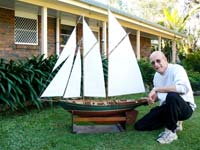 Dave Michel with Elsie
Dave Michel with Elsie |

Rick Mayes with his Bluenose |
Good fun completely in the windling tradition and it should be stressed that neither of the models hulls are strictly Bluenose, but `close’ anyway, both hulls built for sailing by the late Neville Natrass a talented ship modeler from Australia. I am all for margins of variance and as many know, the real Elsie was in fact a Gloucester schooner out of Ma, USA. Rick Mayes boat launched 19th July is visually pretty close considering that he used Bluenose plans and built her up from the deck as well as following a series of photographs.
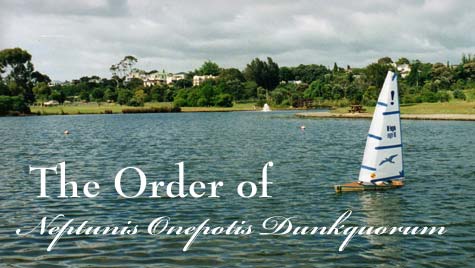
“You know (said a few Ancient Mariners who saw it happen) maybe Mark can walk on water” as they watched me one 12th day of August some years back, pick my way along the water-obscured concrete path at our sailing pond. Then the myth became reality as path became pond and I suddenly disappeared into the drink, (in my opinion parting the black sea with grace and dexterity). In so doing I therefore joined others as members of the order of `Neptunis Onepotis Dunkquorum‘ (Neptunes Onepoto dunkers!)
I didn’t intend to make a habit of falling into ponds but well remember at age ten falling into a huge pond in my home city of Georgetown, then British Guiana and hanging onto a long pole held out to me by an Uncle whom I had been watching sail his free-sail model yacht. Twice, both never intended is enough , anyway eat your hearts out you landlubbers!
I’ve started lately referring to my Spencer schooner Fijipsy Jack as `Cover Girl’ since she occupied an almost-solus position on the cover of Marine Modelling International’s November issue last year. The photograph used, taken by Richard Plinston, made it a `bewdy’ of a cover as the Australians might say, and thanks also to Barrie Stevens the editor. You judge for yourself.

I think it is an American expression, equivalent to pulling your leg, just joking, having you on, etcetera etcetera, but since it is about fun (with disbelief tales content) funnin ya is a great one, in fact it’s most appropriate!
I’d be `funning’ readers (but I think that I already often do!!!) by saying that the photo above left is of a migrating duck flown all the way to New Zealand after being personally set free and into flight in Alaska by Sarah Palin, or that the Cayman alligator in the second photograph inhabits the quiet and peaceful lagoon where we sail in New Zealand, and where it has been known to chew up model sailing boats! I believe in `lightening up’ and `funning’ readers who should bear in mind that there is always the possibility of a bit of fiction (or is it fun-tion?) lurking in these columns of mine. A Trinidadian chap I knew in my days in the Caribbean used to refer to it as spooksing!
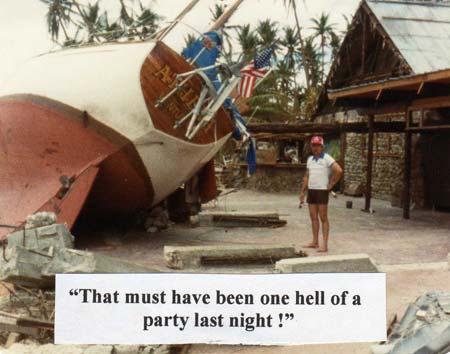
I know that I was younger (and with a trimmer figure then)... |
... but it must have been a hell of a party the night before though I don’t remember a thing about it! “Are you chaps absolutely sure that this was where we moored the boat last night!” (Cyclone damage Fiji, the boat that blew in for breakfast and the pondering writer)
In Essex, Connecticut a club called the Dry Pants Model Yacht Club race CR914 yachts in a Spring, Summer and Fall Series. Those who think that this club suggests any association with those who might have suffered from incontinence, think again. The DPMYC sailors keep their pants dry because they are RC model sailors, as opposed to those who sail on board fullsize yachts and are often prone to get their pants wet from spray.

Painting by Nina Hipkins at 90 years |
`Just as the ocean wears away the rocks and bends the contours of the shore to it’s own will, so it washes over a man’s mind, smoothing the sharp edges, knocking off the conceits, flattening the prejudices so that he is left with a different instrument with which to govern his life’. (Frank Mulville)
 |
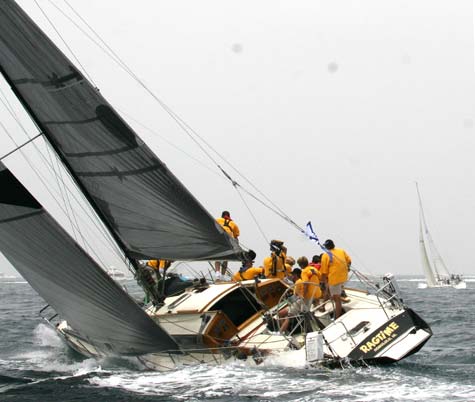
photo by Rich Roberts |
Forty five years ago, before I even knew him, my friend John Spencer designed and build a 60’ plywood yacht for a client in Auckland as an Auckland Hauraki Gulf harbour racer and called her Infidel. After great success here she was bought by an American somewhere around 1970 and went to the US West Coast where as Ragtime over the years she became a legend in her lifetime winning the Transpac race to Hawaii four times, and taking line honours in the classic 3,500 mile California to Tahiti race last year where she set a new record and won on corrected time.
Perhaps seen by Australians as a threat, Infidel was handicapped out of the Sydney to Hobart which irked John and he spoke to me while we were seated one rainy evening in his Bay of Islands home `office’ in the years of our friendship. A Northland rain poured for over an hour, the lights flickered constantly as a thunderstorm with lightning passed over Russell. Over his gin, John muttered “It’s those blasted Australians again!”
Sailed back to New Zealand her original home by her latest owner, Chris Welsh of Rhode Island and crew she took part in the Auckland to Russell Coastal Classic, where in abominable weather, Ragtime finished third in the Monohull division.
Thanks to Rich Roberts of Newport I am able to show you the above photo of his of the legendary boat off Newport under spinnaker – John who watched the progress of his creation for many of his living years, would certainly be thrilled to bits that his old girl came home, that her owner had Infidel on her transom. and that so many years later could still mix it with many of todays monohulls with canting keels and perform with credit.
 |
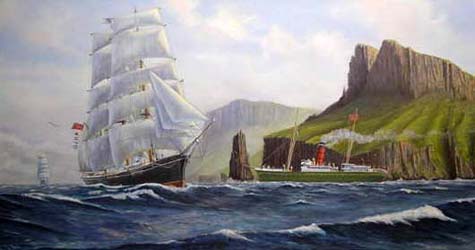 |
Ron Scobie is a marine artist in Sydney, Australia whom I have come into contact with, all because I was impressed by his painting done as a commission a few years ago and sought his permission to reproduce it in this column. This led to a pleasurable exchange of emails between us that continues. Ron, who has had a passion for boats of all types has over the years, has built boats, skippered boats and drawn and painted boats and the painting above titled Passing Cape Pillar was done as a commission in 2004. It shows the blue gum clipper Harriet McGregor passing the Union steamship Rotomahana at the entrance to Hobart’s Storm Bay close to Cape Pillar.
I also particularly like his painting Running down her Easting of the clipper barque Brierholme (below) crossing the Southern Ocean met by two black-browed Albatrosses. The term `Running down her Eastings’ was a common expression of seamen and related to ships leaving England, travelling down the Atlantic and around Africa’s Cape of Good Hope picking up the predominantly Westerly winds at about latitude 44 degrees S for a fast easterly trip across the bottom of the world to Tasmania. Thanks to the artist (also shown below) now I know a few more things than I knew before.
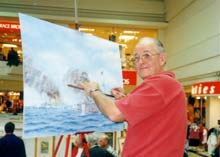
The artist at work |
 |

I have always been amazed at just how many different types of model sailboating either exists or once existed before you and I were in this world. I am grateful to Marine Modelling International with whom I have had a long association for adding to my knowledge in their October issue last year, their article on the Cornish `Cokyn-Baba’ simple easy to make and free-sail boats written about by Alistair Roach of the UK
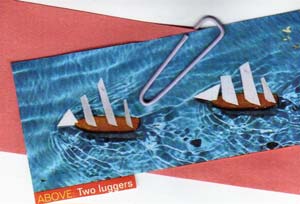
Photo by Alistair Roach |

"The first launch" photo by Jayne Morris |
 |
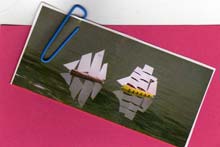
Photo by Daphne Roach |
The practice going back maybe 150 years was for little boats, their hulls made of cork sanding blocks and in lengths of 110 to 120mm, sails from thin ply and keels of 1.5mm metal and the article in the Marine Modelling International issue mentioned is comprehensive to say the least with drawings and a `source for a kit of material to enable you to make two boats at a cost of three UK pounds plus postage from Alistair who designed (and probably made a few if not all of the ships shown and who kindly granted me permission to use them. (Alistair Roach, Windy Corner, Weston Town, Evercreech, Somerset BA4 6JG United Kingdom.
Not with intent to depress people, rather to remind us of the reality of life. A poem of mine to close, even just to jolt us back to remembering that people die daily, the eventual fate of each and every one of us, the final rule of the game called `LIFE’. Each day, we should treat those whom we love as though they might just not be here to love tomorrow.
Tides come and go, winds rise up and blow,
dusk to dawn oft no time to warn,
impossible to guess let alone to know
when each of us upon our final tide will go.
Which friends could well without delay,
slip anchor, sail away, within the minute
or the hour, on the morrow, tonight, today…
up and leave loved ones in sorrow,
which ones among us, who for sure can say?
Mark Steele
| 
